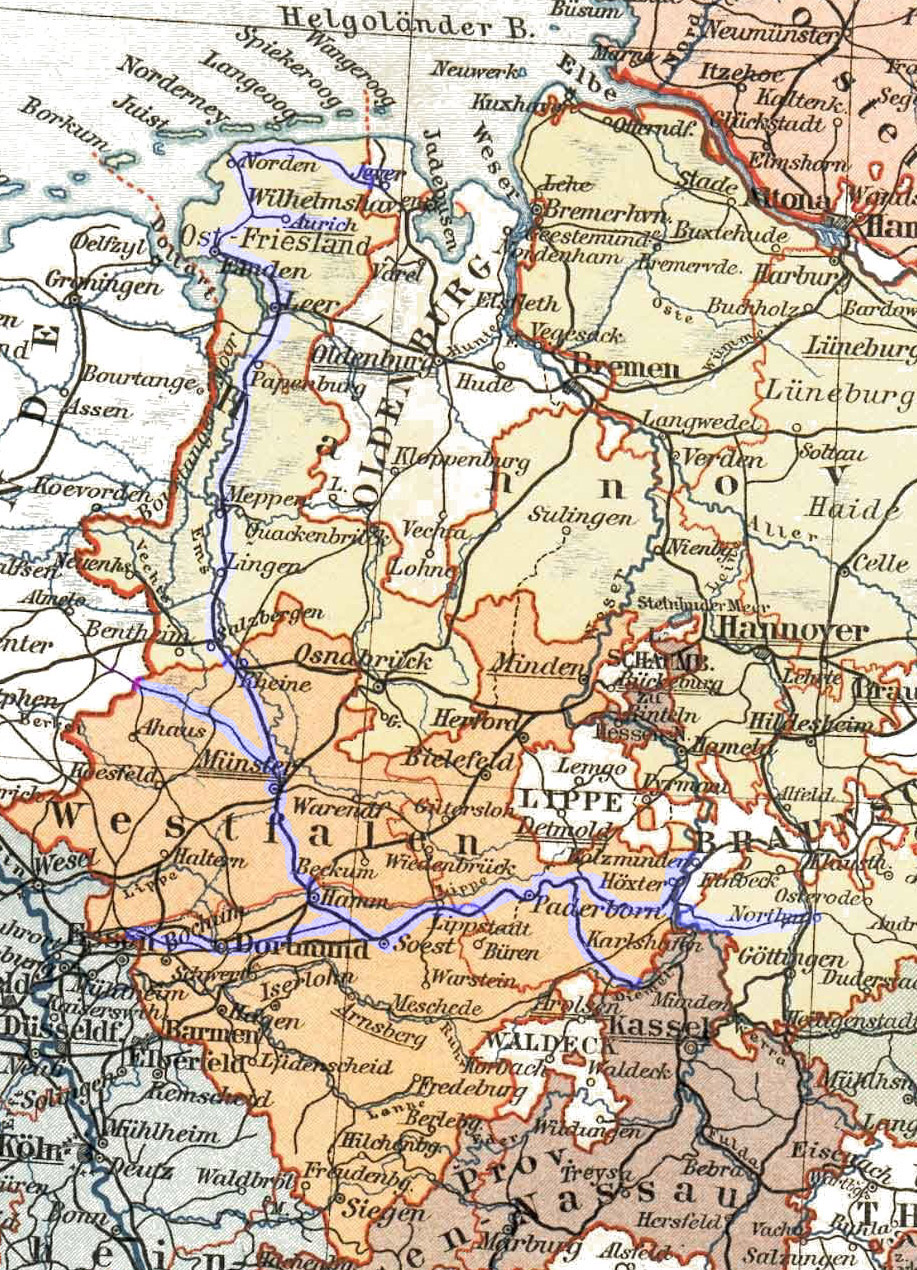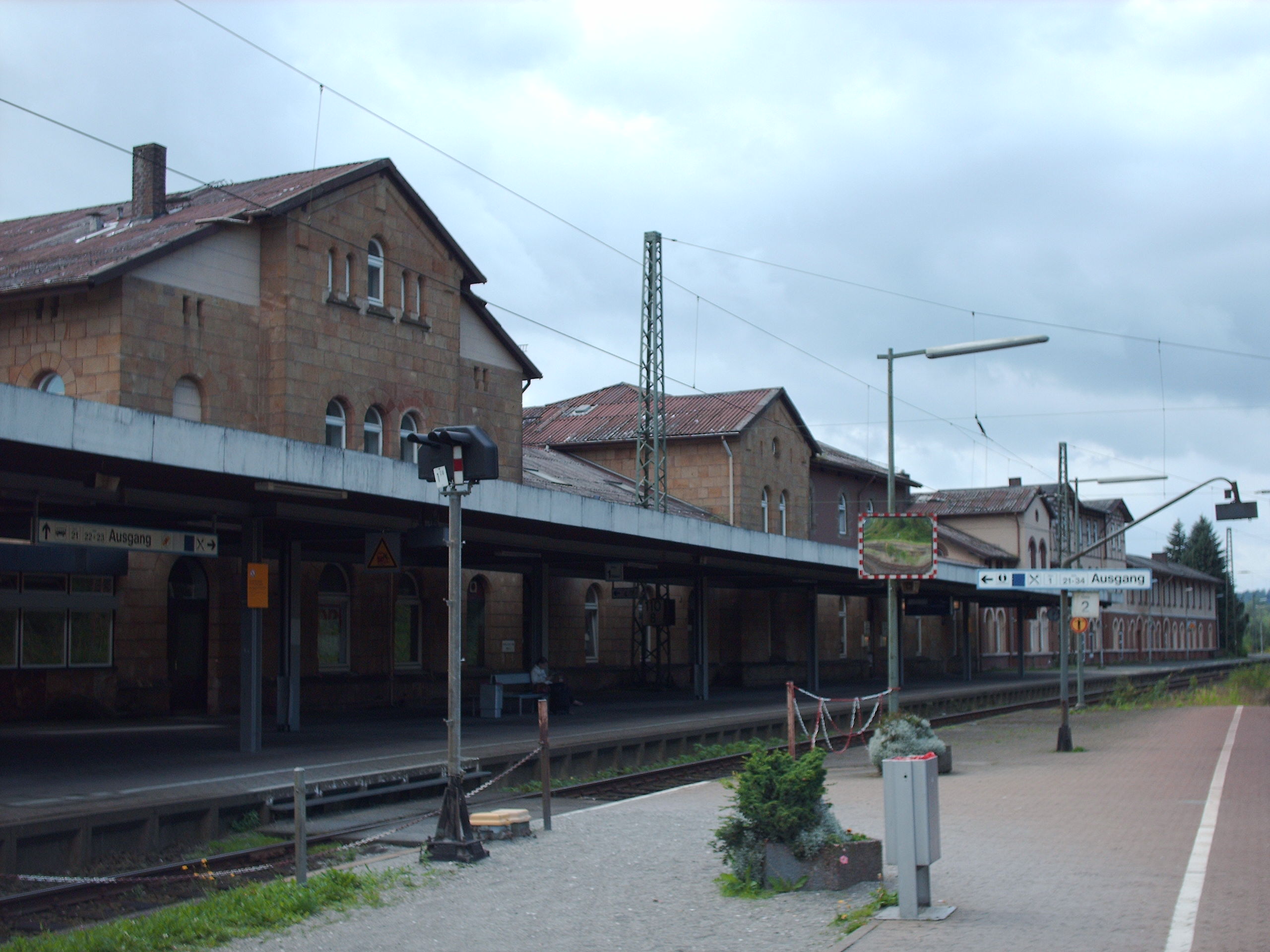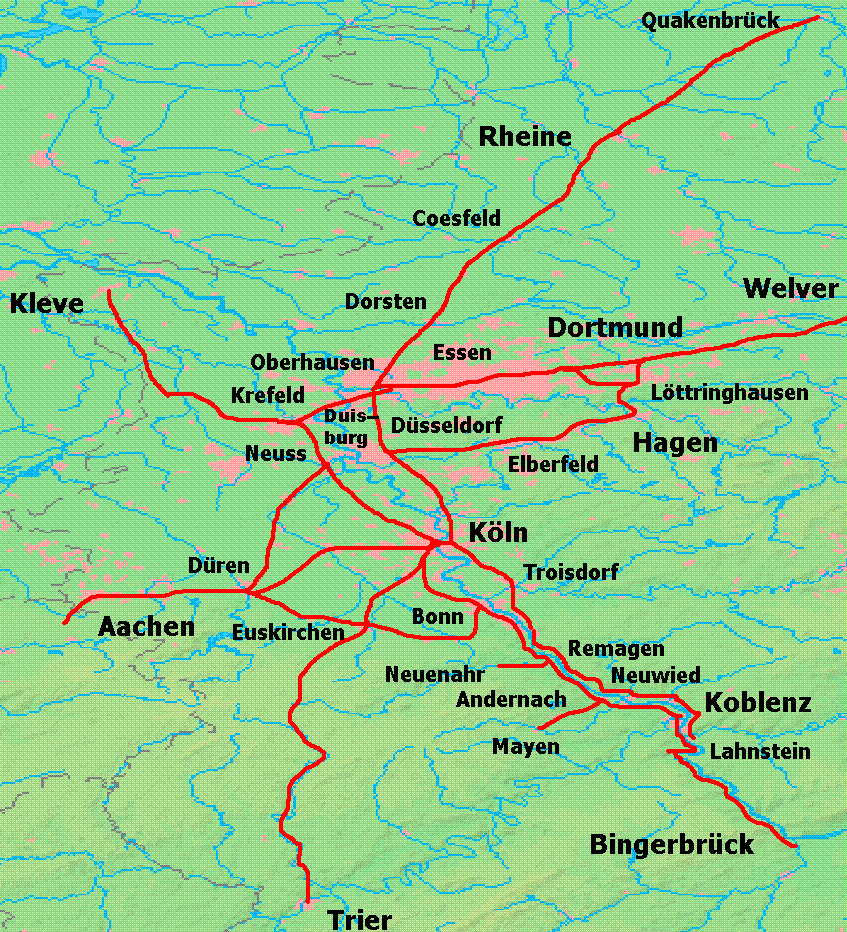|
Royal Westphalian Railway Company
The Royal Westphalian Railway (german: Königlich-Westfälische Eisenbahn, KWE) was a German rail company established in 1848 with funding from the Prussian government, which later became part of the Prussian State Railways. The network eventually extended about 315 km from Rheine via Hamm to Warburg and from Welver (near Hamm) to Oberhausen. History The ''Royal Westphalian Railway'' was initially established only to fill the 32 km-long gap between Hamm and Lippstadt, connecting the Münster–Hamm line of the ''Munster–Hamm Railway Company'' (''Münster-Hammer Eisenbahn-Gesellschaft'') opened in 1848 with the line being constructed at the same time by the ''Cologne-Minden-Thuringian Connection Railway Company'' (''Köln-Minden-Thüringischen-Verbindungs-Eisenbahn-Gesellschaft'', KMTVEG). The latter company, however, went bankrupt in 1848 and further construction and the line's later operations were taken over by the Prussian government. The cause of the bankruptc ... [...More Info...] [...Related Items...] OR: [Wikipedia] [Google] [Baidu] |
Altenbeken Viaduct
The Altenbeken Viaduct (german: Altenbekener Viadukt, also known as ''Bekeviadukt'' or ''Großer Viadukt Altenbeken'') is a long and up to high double track limestone railway viaduct. It spans the Beke valley, west of the town of Altenbeken, in the ''Land'' of North Rhine-Westphalia, Germany. The viaduct is Europe's longest limestone bridge, and its construction was one of the earliest significant events in the history of rail transport in Germany. As part of the Hamm–Warburg railway between Paderborn and Altenbeken, it is still in use today. It is also the emblem of Altenbeken, and is depicted, in stylized form, on the coat of arms of the municipality. History The viaduct was built by the Royal Westphalian Railway Company, and was inaugurated on 21 July 1853 by King Frederick William IV. He was the one who coined the phrase ''"I had thought I would find a golden bridge, because so many terrible dollars have been spent"''. The construction and opening of the viaduct an ... [...More Info...] [...Related Items...] OR: [Wikipedia] [Google] [Baidu] |
Altenbeken–Kreiensen Railway
The Altenbeken–Kreiensen railway is part of a former long-distance route in Germany from the Ruhr area via Altenbeken, Höxter-Ottbergen, Holzminden, Kreiensen and Seesen towards Berlin. The once continuous double track main line railway is now operated as a single track east of Ottbergen. It runs through the Egge ridge and along the northern edge of the Solling hills. The section in North Rhine-Westphalia up to and including Holzminden is also known as the Egge Railway (german: Eggebahn). History The line from Altenbeken to Godelheim was opened on 1 October 1864 by the Royal Westphalian Railway Company and extended on 10 October 1865 to Holzminden. It connected with the Brunswick Southern Railway, which was opened by the Duchy of Brunswick State Railway between Holzminden and Kreiensen on 10 October 1865, creating a link with Brunswick (Braunschweig). To connect with the Brunswick area the line bypassed the town of Einbeck with two tunnels and a long climb. Originally ... [...More Info...] [...Related Items...] OR: [Wikipedia] [Google] [Baidu] |
Münster–Rheine Railway
The Münster–Rheine railway is a nearly 39 km long main line railway from Münster to Rheine in the German state of North Rhine-Westphalia. It is entirely double track and electrified. It was opened by the Prussian government-funded Royal Westphalian Railway Company in 1856 and is one of the oldest railways in Germany. History The ''Royal Westphalian Railway'' (german: Königlich-Westfälische Eisenbahn, KWE) built its main line from Hamm to Warburg in the early 1850s. In 1855, the KWE took over the ''Munster-Hamm Railway Company'' (''Münster-Hammer Eisenbahn-Gesellschaft)'', together with its line to Munster, which it then extended further north to Rheine. It opened its line on 23 June 1856, reaching Rheine station on the same day as both of the two sections of the Hanoverian Western Railway were completed to the station: the line from Löhne and the Emsland Railway to the North Sea port of Emden. In 1879, the Rhenish Railway Company (''Rheinische Eisenbahn-Gesellsch ... [...More Info...] [...Related Items...] OR: [Wikipedia] [Google] [Baidu] |
Kassel–Warburg Railway
The Kassel–Warburg Railway is a line that connects Kassel in the north of the German state of Hesse with Warburg in eastern Westphalia. The line was opened in 1848 and is one of the oldest railways in Germany. It forms part of the Mid-Germany Railway (german: Mitte-Deutschland-Verbindung), an east–west through line in central Germany, used by long-distance and regional passenger and freight trains. History The track was originally built by the Frederick William Northern Railway (''Friedrich-Wilhelms-Nordbahn-Gesellschaft'', FWNG) as the ''Carl Railway'' (or ''Charles Railway'', german: Carl Bahn) from Kassel, the capital of the Electorate of Hesse (''Kurhessen''), to the port of Bad Karlshafen (then called ''Carlshaven'', German for "Port Charles", after Charles I, Hesse’s ruler from 1670 to 1730) on the left bank of the Weser, one of the northernmost places in the contiguous part of Kurhessen. The first section from Grebenstein via Hümme to Karlshafen on the south ban ... [...More Info...] [...Related Items...] OR: [Wikipedia] [Google] [Baidu] |
Gelsenkirchen
Gelsenkirchen (, , ; wep, Gelsenkiärken) is the 25th most populous city of Germany and the 11th most populous in the state of North Rhine-Westphalia with 262,528 (2016) inhabitants. On the Emscher River (a tributary of the Rhine), it lies at the centre of the Ruhr, the largest urban area of Germany, of which it is the fifth largest city after Dortmund, Essen, Duisburg and Bochum. The Ruhr is located in the Rhine-Ruhr Metropolitan Region, one of Europe's largest urban areas. Gelsenkirchen is the fifth largest city of Westphalia after Dortmund, Bochum, Bielefeld and Münster, and it is one of the southernmost cities in the Low German dialect area. The city is home to the football club Schalke 04, which is named after . The club's current stadium Veltins-Arena, however, is located in . Gelsenkirchen was first documented in 1150, but it remained a tiny village until the 19th century, when the Industrial Revolution led to the growth of the entire area. In 1840, when ... [...More Info...] [...Related Items...] OR: [Wikipedia] [Google] [Baidu] |
Herne, Germany
Herne () is a city in North Rhine-Westphalia, Germany. It is located in the Ruhr area directly between the cities of Bochum and Gelsenkirchen. History Like most other cities in the region, Herne (ancient Haranni) was a tiny village until the 19th century. When the mining of coal (and possibly ore) and the production of coke (the fuel processed from the harvested coal) and steel began, the villages of the Ruhr area slowly grew into towns and cities because of the influx of people, mostly from the East (Germany as well as East-Prussia, Bohemia, Moravia, Silesia, Poland and beyond, even Italy and Spain), looking for, and finding, work. Herne is located on the direct axis between Bochum to the South and Recklinghausen to the North, with Münster yet further North; Gelsenkirchen lies to the West, and Castrop-Rauxel and Dortmund to the East. The physical border between Herne and Recklinghausen in fact is, and has been for a long time, the bridge at the Bochumer Strasse across the Rh ... [...More Info...] [...Related Items...] OR: [Wikipedia] [Google] [Baidu] |
Welver–Sterkrade Railway
The Welver–Sterkrade railway is a former through railway line from the Westphalian town of Welver to Sterkrade in the western Ruhr region in Germany, which is now broken into four disconnected sections. Because its route ran along the Emscher river it was known as the ''Westphalian Emscher Valley Railway''. The sections from Unna-Königsborn to the former Dortmund South station and from Dortmund-Dorstfeld to Dortmund-Mengede is now an entirely two-track electrified railway and is served by the Rhine-Ruhr S-Bahn (lines S 2 and S 4). There are two sections, each of only a few kilometres, in Gelsenkirchen and in Bottrop and Oberhausen, which have traditionally been used exclusively for freight. History The line was built by the Royal Westphalian Railway Company (german: Königlich-Westfälische Eisenbahn, KWE) to connect its network, which at that time mostly ran through northern and eastern Westphalia, to the Ruhr area in the west in order to serve the lucrative traffic from it ... [...More Info...] [...Related Items...] OR: [Wikipedia] [Google] [Baidu] |
World War II
World War II or the Second World War, often abbreviated as WWII or WW2, was a world war that lasted from 1939 to 1945. It involved the World War II by country, vast majority of the world's countries—including all of the great powers—forming two opposing military alliances: the Allies of World War II, Allies and the Axis powers. World War II was a total war that directly involved more than 100 million Military personnel, personnel from more than 30 countries. The major participants in the war threw their entire economic, industrial, and scientific capabilities behind the war effort, blurring the distinction between civilian and military resources. Air warfare of World War II, Aircraft played a major role in the conflict, enabling the strategic bombing of population centres and deploying the Atomic bombings of Hiroshima and Nagasaki, only two nuclear weapons ever used in war. World War II was by far the List of wars by death toll, deadliest conflict in hu ... [...More Info...] [...Related Items...] OR: [Wikipedia] [Google] [Baidu] |
Unna
Unna is a city of around 59,000 people in North Rhine-Westphalia, Germany, the seat of the Unna district. The newly refurbished Unna station has trains to all major cities in North Rhine Westphalia including Dortmund, Cologne, Münster, Hamm, Düsseldorf and Wuppertal. There is also the Regional-Express 7 (Rhein-Münsterland-Express), which runs from Rheine via Cologne to Krefeld. Geography Unna is situated on an ancient salt-trading route, the Westphalian Hellweg. Trade on this route and during the period of the Hanseatic League came from as far as London. The city is located at the eastern extremity of the Ruhr district, about east of the centre of Dortmund. Unna also serves as a dormitory city, being home to many commuters who work in Dortmund and other nearby cities. Local dialects of German include Westfälisch and Ruhrpott. The recreational district of Sauerland is nearby. The River Ruhr runs just south of Unna through Fröndenberg, before heading through the main part ... [...More Info...] [...Related Items...] OR: [Wikipedia] [Google] [Baidu] |
Rhenish Railway Company
The Rhenish Railway Company (German: ''Rheinische Eisenbahn-Gesellschaft'', RhE) was along with the Cologne-Minden Railway Company (CME) and the Bergisch-Märkische Railway Company (BME) one of the railway companies that in the mid-19th century built the first railways in the Ruhr and large parts of today's North Rhine-Westphalia. Foundation The industrialists of the Rhineland and the Bergisches Land, then part of Prussia, sought to avoid paying the high tolls for using the Rhine imposed by the Netherlands and very early in its development, saw the possibility of the new means of transport, the railway. As early as the 1830s committees were established the cities of the Rhineland to promote proposals for building railways. Some of the members of the Cologne committee under David Hansemann (1790–1864)—a merchant and banker from Aachen—and the Aachen Committee favoured a railway line through Belgium to the seaport of Antwerp via Liege. Belgium, which had been established as ... [...More Info...] [...Related Items...] OR: [Wikipedia] [Google] [Baidu] |
Austro-Prussian War
The Austro-Prussian War, also by many variant names such as Seven Weeks' War, German Civil War, Brothers War or Fraternal War, known in Germany as ("German War"), (; "German war of brothers") and by a variety of other names, was fought in 1866 between the Austrian Empire and the Kingdom of Prussia, with each also being aided by various allies within the German Confederation. Prussia had also allied with the Kingdom of Italy, linking this conflict to the Third Independence War of Italian unification. The Austro-Prussian War was part of the wider rivalry between Austria and Prussia, and resulted in Prussian dominance over the German states. The major result of the war was a shift in power among the German states away from Austrian and towards Prussian hegemony. It resulted in the abolition of the German Confederation and its partial replacement by the unification of all of the northern German states in the North German Confederation that excluded Austria and the other Sou ... [...More Info...] [...Related Items...] OR: [Wikipedia] [Google] [Baidu] |








